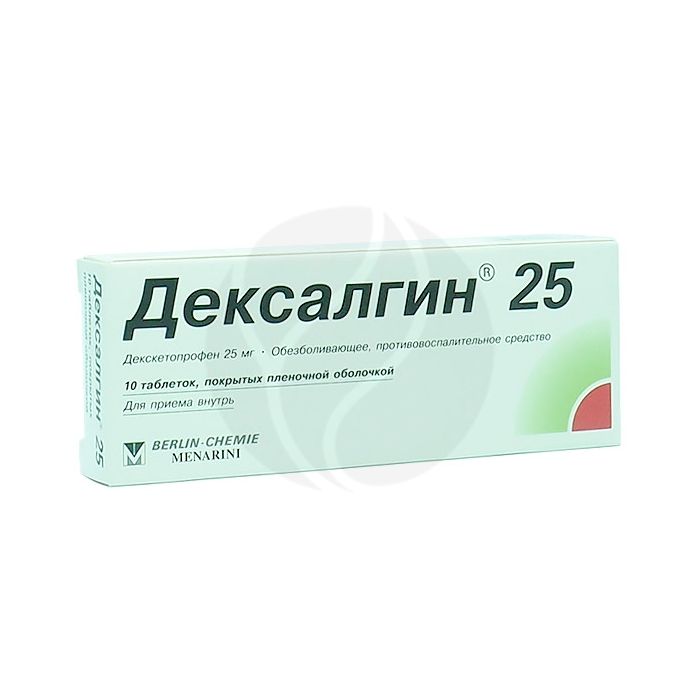Dexalgin 25 tablets, p / o 25mg, No. 10
Expiration Date: 05/2027
Russian Pharmacy name:
Дексалгин 25 таблетки п/о 25мг, №10
Pain syndrome of mild to moderate intensity in the following diseases and conditions:
acute and chronic inflammatory diseases of the musculoskeletal system (rheumatoid arthritis, spondyloarthritis, arthrosis, osteochondrosis);
dysmenorrhea;
toothache.
Set individually.
The average recommended single dose is 12.5 mg (1/2 tab.) 1 to 6 times / day every 4-6 hours as needed, or 25 mg (1 tab.) 1 to 3 times / day every 8 hours.
The maximum daily dose is 75 mg (6 tab.).
In patients with impaired liver or kidney function, in the elderly, the drug should be taken in lower doses - no more than 50 mg / day.
The drug is not intended for long-term use: the duration of administration should not exceed 3-5 days.
Active substance:
dexketoprofen trometamol - 36.9 mg, which corresponds to the content of dexketoprofen - 25 mg
Excipients: microcrystalline cellulose - 141.2 mg, corn starch - 49.6 mg, sodium carboxymethyl starch (type A) - 27.1 mg, glyceryl palmitostearate - 5.2 mg.
The composition of the film shell: hypromellose - 1.34 mg, titanium dioxide (E171) - 0.36 mg, macrogol 6000 - 0.6 mg, propylene glycol - 0.42 mg.
Peptic ulcer and duodenal ulcer;
gastrointestinal bleeding;
active bleeding of various origins;
increased bleeding;
anticoagulant therapy;
Crohn's disease;
nonspecific ulcerative colitis;
bronchial asthma (including history);
severe heart failure;
severe renal failure;
severe liver failure;
pregnancy;
lactation period;
hypersensitivity to dexketoprofen or other NSAIDs.
pharmachologic effect
Non-steroidal anti-inflammatory drug. It has anti-inflammatory, analgesic and antipyretic effects. The mechanism of action of the drug is based on the inhibition of the synthesis of prostaglandins due to the suppression of cyclooxygenase. The analgesic effect occurs 30 minutes after taking the drug, its duration is from 4 to 6 hours.
Pharmacokinetics
Suction
After taking the drug inside, Cmax of dexketoprofen in humans is achieved on average after 30 minutes (15-60 minutes).
Distribution and excretion
Plasma protein binding - 99%. The distribution time and T1 / 2 of dexketoprofen is 0.35 and 1.65 hours, respectively. The average Vd is less than 0.25 l / kg. The main part of the drug is excreted in the urine in the form of metabolites (after glucuronidation).
Indications of the drug
Pain syndrome of mild to moderate intensity in the following diseases and conditions:
acute and chronic inflammatory diseases of the musculoskeletal system (rheumatoid arthritis, spondyloarthritis, arthrosis, osteochondrosis);
dysmenorrhea;
toothache.
Dosage regimen
Set individually.
The average recommended single dose is 12.5 mg (1/2 tab.) 1 to 6 times / day every 4-6 hours as needed, or 25 mg (1 tab.) 1 to 3 times / day every 8 hours.
The maximum daily dose is 75 mg (6 tab.).
In patients with impaired liver or kidney function, in the elderly, the drug should be taken in lower doses - no more than 50 mg / day.
The drug is not intended for long-term use: the duration of administration should not exceed 3-5 days.
Side effect
From the digestive system: heartburn, abdominal pain; rarely - erosive and ulcerative lesions of the gastrointestinal tract.
From the side of the central nervous system and peripheral nervous system: headaches, dizziness, nervousness, sleep disturbance, paresthesia.
From the side of the cardiovascular system: palpitations, increased blood pressure.
Allergic reactions: skin rash, bronchospasm.
Others: chills, swelling of the limbs, photosensitivity; rarely - a change in the picture of peripheral blood, renal dysfunction.
When used according to indications and in recommended doses, the drug is well tolerated.
Contraindications for use
peptic ulcer of the stomach and duodenum;
gastrointestinal bleeding;
active bleeding of various origins;
increased bleeding;
anticoagulant therapy;
Crohn's disease;
nonspecific ulcerative colitis;
bronchial asthma (including history);
severe heart failure;
severe renal failure;
severe liver failure;
pregnancy;
lactation period;
hypersensitivity to dexketoprofen or other NSAIDs.
Application during pregnancy and lactation
The drug is contraindicated for use during pregnancy and lactation due to the lack of reliable clinical data confirming the safety of its use.
Application for violations of liver function
The drug is contraindicated in severe liver dysfunction.
In patients with impaired liver function , the drug should be taken at lower doses - no more than 50 mg / day.
Application for impaired renal function
The drug is contraindicated in severe renal impairment.
In patients with impaired renal function , the drug should be taken at lower doses - no more than 50 mg / day.
special instructions
Care should be taken when prescribing the drug to elderly patients, patients with allergic reactions, with systemic diseases of the connective tissue and patients with impaired hematopoiesis.
Patients should be informed that in the event of side effects, as well as in the absence of a clinical effect within 3-5 days of treatment, it is necessary to inform the attending physician about it.
Special care is required with the simultaneous use of Dexalgin 25 with phenytoin, sulfonamides and drugs that reduce blood clotting.
Influence on the ability to drive vehicles and use mechanisms
Since Dexalgin 25 can cause dizziness and drowsiness, the drug should be prescribed with caution to patients engaged in potentially hazardous activities that require increased attention and speed of psychomotor reactions.
Overdose
Treatment: gastric lavage; if necessary, symptomatic therapy.
Drug interactions
The simultaneous use of Dexalgin 25 with other NSAIDs may increase the risk of side effects.
The simultaneous use of Dexalgin 25 with lithium preparations can increase the concentration of the latter in the blood plasma.
Caution should be exercised when using NSAIDs less than 24 hours before the start of use or after the end of therapy with methotrexate, since its level in the blood (and, therefore, toxicity) may increase.
Some cases of bleeding with the simultaneous use of NSAIDs and anticoagulants are described.

